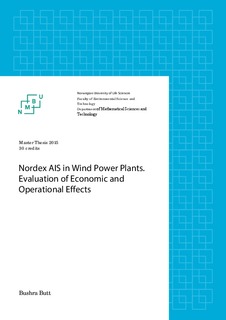| dc.description.abstract | There are many cold climate sites around the world that offer great wind energy potential with good wind resources and low population density (Wind Power Monthly, 2015). Yet the sites suffer from icing, which reduce the availability of, and the energy production from the turbine.
Optimizing wind farms in cold climate is currently an important topic in the wind industry. This December an event was hosted by Wind Power Monthly, where the focus was on the commercial and technical complexities impeding the operation of wind farms in cold and difficult climates. One of the main topics was solutions on icing standardization measures to reduce uncertainties and energy losses whilst enhancing the project bankability potential1.
The reason I chose this topic is, icing on wind site has been a huge challenge for many sites and is going to be a topic of discussion in coming years in Norway. In addition, there are many wind site that has been given concession by Norwegian Water Resources and Energy Directorate that may face icing problems due to the location. In this paper, the focus has been to suggest a recommendation for a solution to the challenge of reducing financial risk and energy loss when developing wind farms in cold climates. To make this recommendation it has been important to provide an overview of which icing challenges are present in Nordic countries, and present a viable solution for these problems.
The paper concludes that it is beneficial to invest in anti-icing technology (AIS) to avoid production loss due to ice in cold climate sites. The main analyses have been carried out using net present value (NPV) with and without the AIS in a cold climate wind site. My results indicate that the AIS will positively affect a project financially if the loss due to icing is higher than 6 per cent. The results further indicate that in order to optimize the project value, there is need of a combination of power curve and availability warranties delivered with the AIS. This warranty design may help in reducing the annual energy production (AEP) uncertainties, potentially ease access to capital and reduce the cost of financing sites. The recommendation is based on interviews with potential customers of AIS. Individual warranty design for each site is recommended to minimize Nordex’ risk associated with the given warranty. | nb_NO |
